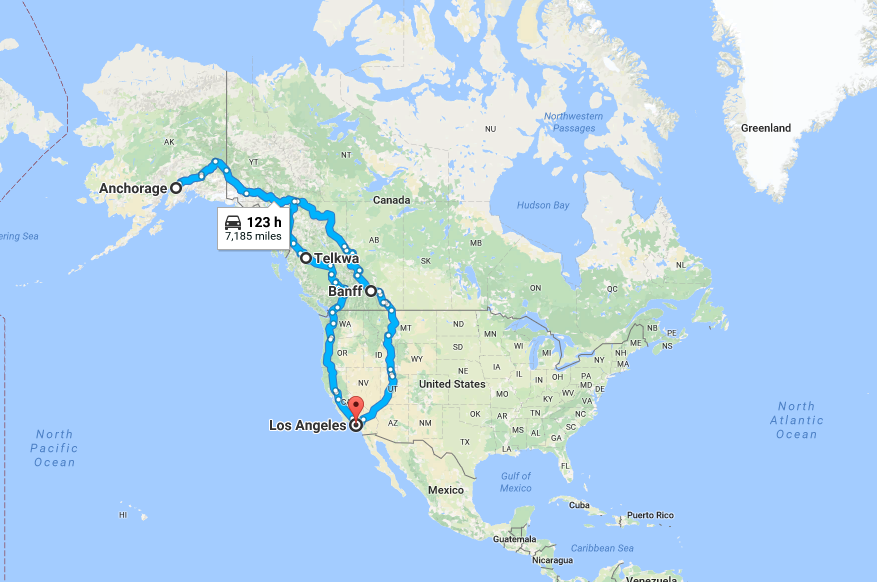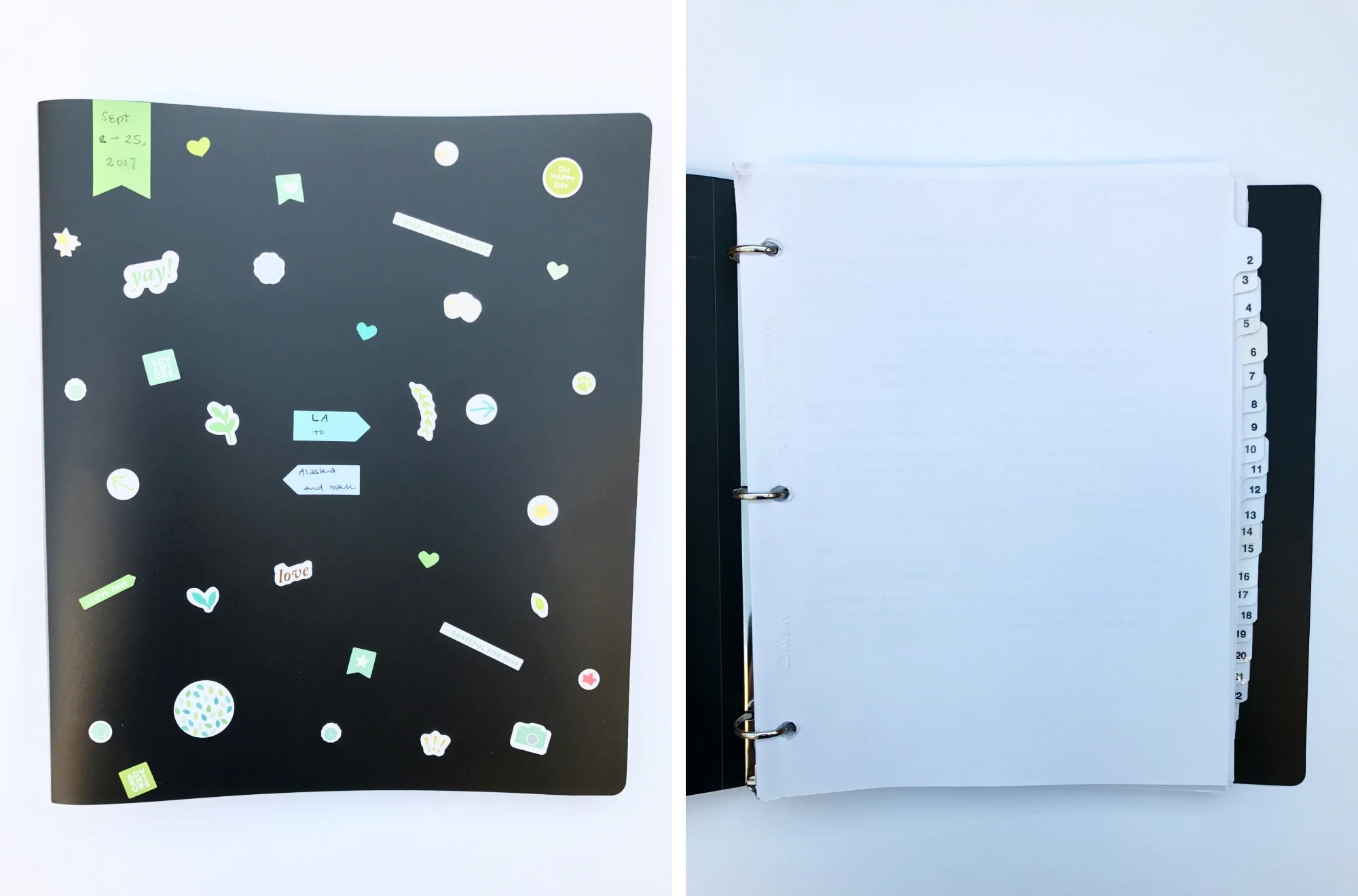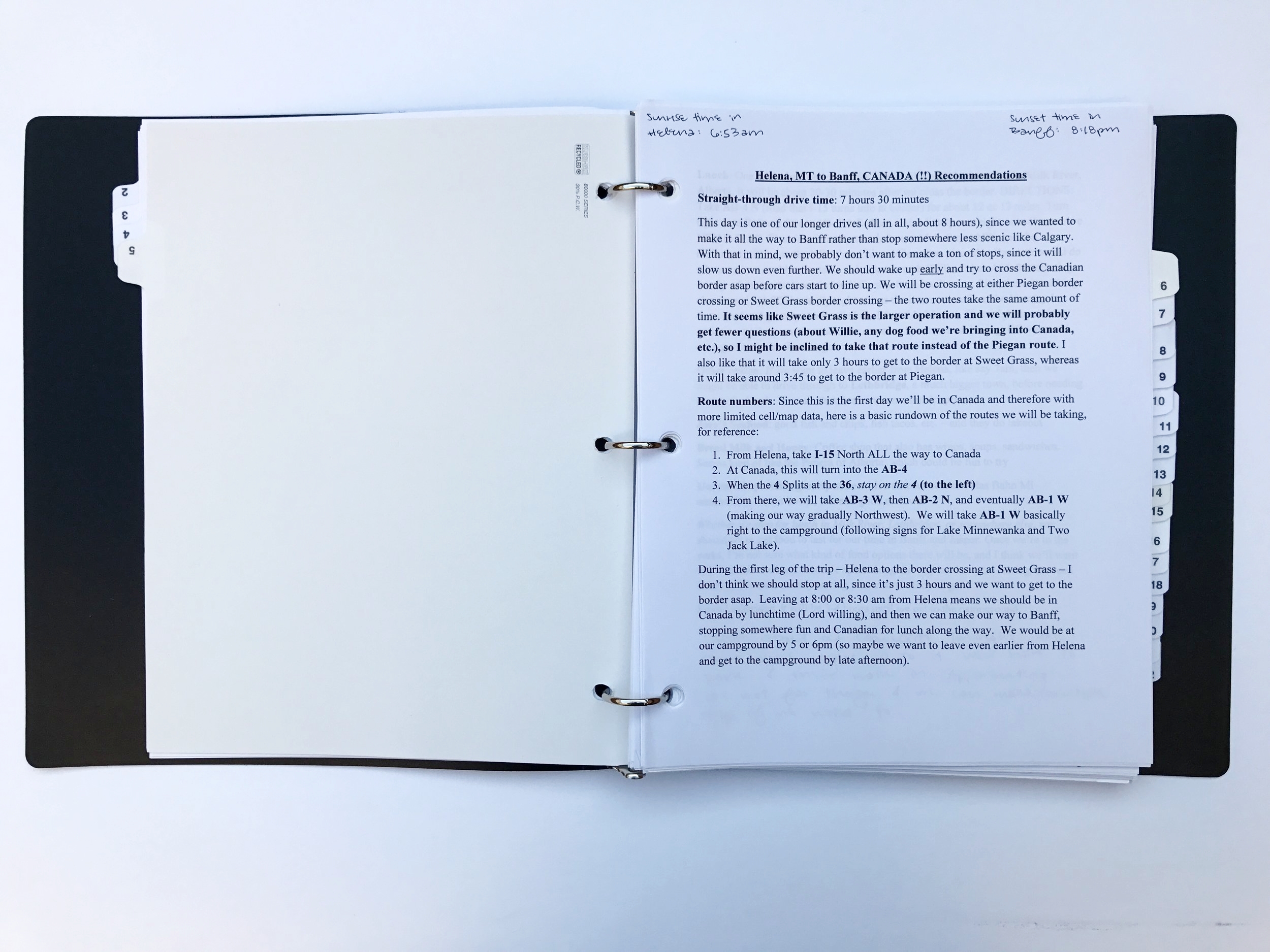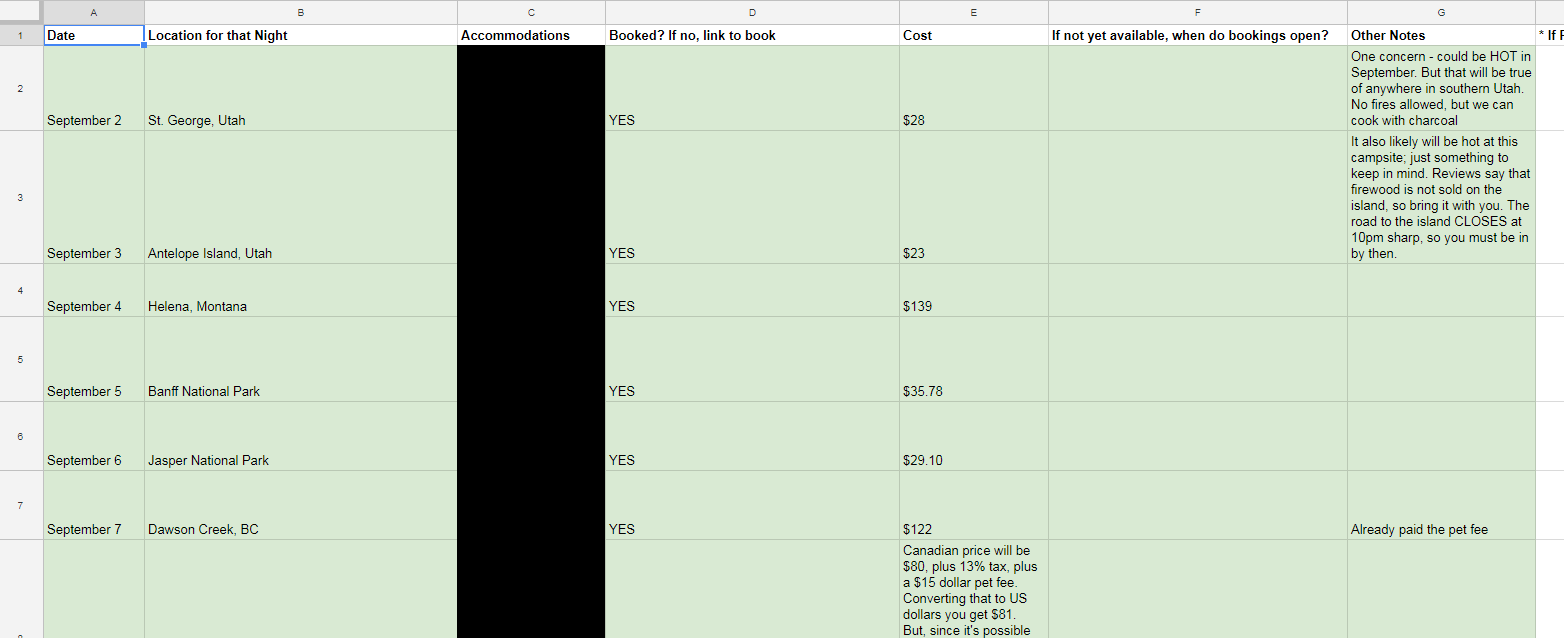Hi there! If you've just found this page through Google and are interested in driving from California to Alaska, you are in the right place. Since blogging our trip, this post in particular has gotten a lot of search engine traffic, so I wanted to write a short new introduction for anyone just starting out on planning their drive. The blog post below, on planning the route, is from August 2017. We drove to Alaska and back in September 2017. If you want to see all of my posts on that drive--recaps, takeaways and musings, recommendations, packing lists, etc.--click here. Overall, if you are thinking about doing this drive, just GO. I was unemployed for a month and threw caution to the wind and had the best month of my entire life (so far). I can't recommend the experience enough. And if you have logistical questions, feel free to ask on my Contact page.
Without further ado, here's the original post on planning the route:
I cannot tell you how excited I am to start a new category on my blog today--our California to Alaska road trip! A big part of the reason I started this blog when I did was to share about this upcoming trip. We dreamed it up a year ago. I'm not exactly sure how it even popped into our heads, but I've wanted to see Alaska my whole life and have never been. When we started talking about going, it quickly became clear that we could not go without Casper. He always loved road trips, and this one (all 7,200 miles of it) would be his crowning glory of all road trips.
One of the clearest memories I have from the "wake" we had for Casper is sobbing to our LA friends and family, barely able to choke out the words, "I just wish he could come with us to Alaska." Even though it stings to remember that day because I was SO incredibly devastated, it's a warm memory, too, because I can still feel the love and physical presence surrounding me during that sob-fest--friends' hands holding mine and arms around me. I remember standing in the kitchen that day with one friend, wondering aloud how this could ever be okay. Will we still go on the trip? How can we do it without our dog? Well, as the weeks have passed, healing has happened. This trip is going to be more meaningful than we ever imagined when we started planning it in 2016. In the car with us will be Willie, Casper's chosen brother, and also a cherished wooden box of ashes, all that we have left of Casper. Yes, we are going to scatter (some, not all of) Casper's ashes on the trip.
But backing up a bit, I want to share our planning process for this trip. I would conservatively estimate that I have spent 100 hours just researching for this trip (not counting the hours we have spent shopping for supplies, talking about it, packing, getting the car ready, etc.). A LOT of that research (probably the majority) has been reading people's blogs who have driven from the continental US through Canada to Alaska. I've learned so much and been so inspired reading about others' travel. Here are a few favorite blogs that detail their trips North:
Gone with the Wynns--amazing blog written by a couple who drove their RV through Canada to Alaska. They have dozens of posts about the journey and provide a lot of detail about things like road conditions, crossing the border, etc.
My Itchy Travel Feet--good practical advice and city-by-city recaps of driving the Alaska Highway
Mali Mish--another good guide to the distance they covered each day
North to Alaska--this is a company, but they have a page called "Community Routes" with dozens of little travel journals from people who have done the trip!
This isn't intended as a criticism of any other blogs, but one thing I felt myself craving when reading about people's road trips to Alaska was detail. I wanted to know everything about their planning process, each stop they made, and just generally how they did it. So get ready for a TON of detail in this post. If you are planning a similar trip (even if you're reading this long after I post it), I would love to answer any questions you have--Contact me!
Though I am a big fan of spontaneous trips (our Yosemite trip was planned in less than a week and our recent Santa Cruz mountains getaway was pretty last-minute, too), the #1 thing I can recommend in planning a trip where you're traversing a continent is to plan it well in advance. From what I've read, in summer months it's totally possible to drive to Alaska with no advance reservations for lodging and without a clear plan of a destination each day. That said, for us this is a trip of a lifetime. In planning it I tried to build in flexibility and room for spontaneity, but I also wanted the best of the best for us. I wanted to stay at the coveted campsites that you have to book the day they become available online (true story, I set my alarm for 5am to book some campsites the minute they opened--and later that day the whole campground was full). I wanted to find a dreamy suite overlooking Vancouver, and I wanted to rent adorable cabins in the wilderness that fill up months ahead of time. Yes, you can fly by the seat of your pants, and that would be fun in a different way. But for all my fellow type-A people reading, here's how we planned our Alaska trip!
Trip Stats:
Origin: Los Angeles, California
Farthest Point: Anchorage, Alaska
Ending destination: Los Angeles, California (7,200 miles total; 123 hours in the car--almost the distance of driving between my hometown of Raleigh, NC, and Los Angeles three times).
Dates on the road: September 2 to September 25, 2017
States and Provinces Covered: California, Nevada, Arizona, Utah, Idaho, Montana, Alberta, British Columbia, Yukon Territory, Alaska, Washington, and Oregon.
International Border Crossings: 4
Time Zones: 3
Here's a map of our route (as you'll see, we're taking one way up and another way back down, so we can see more of the continent). Taking the seemingly-less-direct route through Utah, Idaho, Montana, and Alberta on the way up only adds a few hours to the entire trip, and it lets us see Banff and Jasper National Parks in Canada.
Planning Timeline:
10-12 months out: decide dates and destinations within the trip. Grace and I did this over two days at favorite coffee shops, looking at a map and doing a lot of googling where to stay and information about the various towns along the way. I ended up tweaking a few things as I later went and actually booked accommodations for each night (i.e., sometimes I would end up picking a town 30 minutes further down the road if it had better hotel or campground options, etc.), but it was really helpful to have a general structure that Grace and I had agreed on together for each day of the trip.
6-10 months out: reserve accommodations for the trip during this time. The reason I did this over such a long span of time was because (a) I didn't want to drop around $2000 on accommodations all at once (sidenote: this trip hasn't been cheap as far as road trips go. I am going to talk about the financial side of things and budgeting in a separate post coming soon); and (b) some reservation windows didn't open until a certain number of months out, especially for campgrounds. So instead, over a period of 5 or 6 months I made reservations little by little. The first things I booked were Airbnb's and campsites (especially at the more desirable places like Banff and Jasper) because those tend to fill up quickly. Hotels seem to have more availability. It might seem daunting to book accommodations for several weeks' worth of travel, often only staying one night in each location, but it's the BEST feeling when you book everything. We have over 20 different reservations for our road trip, and the day I booked the last one I opened a bottle of champagne to celebrate. That was back in May--and having it all done months before our trip even begins has allowed us to go into it relaxed, not frantic.
Also 6-10 months out: locate your passports if you're driving through another country, make sure they won't expire within 6 months of your travel, and look into car insurance for the country you'll be going to if necessary.
4-5 months out: decide what you're going to do with your job, home, car (we're taking Grace's car and I normally park on the street and don't want to leave it out that long, so I'm putting mine in storage), etc. If you're going on a trip as long as ours, it's probably a good idea to figure out how that will work with your job well in advance.
2-3 months out: start thinking about packing lists, supplies, and dog-related needs if you're bringing a dog. Canada has certain requirements for bringing a pet (as well as pet food) over the border, so we made a special appointment with our vet to talk about it.
1 month out/last few weeks before leaving: purchase supplies you will need, get your car serviced to make sure it's in tip-top shape for the drive, call your credit card company to make sure they know you'll be traveling and won't freeze your card, get some cash (including Canadian dollars) in advance, set up an international cell phone plan (I have Verizon and they have a good deal for using your phone in Canada), pack your bags, and say goodbye to friends and family for a few weeks!
How I Have Prepared and Stayed Organized:
A couple of weeks ago (at the one-month mark 'til leaving for our trip), I surprised Grace with this:
Now affectionately called "The Book." It is the product of months and months of research, planning, saving, booking, and more. Basically, I have a tab for each day of the trip and under that tab I have a printout of our accommodations reservation (whether campsite, hotel, or vacation rental), a list of addresses and phone numbers we need, a breakdown of roadside attractions and recommendations, and details like what time the sun rises and sets (we are changing time zones frequently and sometimes the sunset time will shift by as a much as an hour from day to day on the trip). I also have maps for each area where we'll be spending time. Making something with this level of detail might not be your travel style, and that's fine! But we want to be able to unplug and not look at our phones as much as possible, so that's why I made The Book instead of planning on using apps or notes on my phone constantly.
Before The Book was complete, I used (and still use) a google spreadsheet to keep me organized. This was especially helpful while I was going through the slow process of booking all of our accommodations. Here's a screenshot of my setup (with the exact places we're staying removed--sorry Internet, but I don't want to put the exact day and campsite number of where we'll be camping--after our trip is over I'll be more than happy to share every single detail of where we slept).
As you're probably gathering from this post, my dream and heart for this trip is that it will be carefree, without the need to find a place to stay on the fly or do research while we travel. With that in mind I've tried to be extremely detail-oriented and do everything I can possibly do ahead of time. An example of that is pre-ordering our Canada Parks Discovery Pass, which you have to have to go into the Canadian National Parks (seen in the first photo of this post). This year they are free to celebrate Canada's 150th anniversary of confederation (such a happy coincidence once I found that out--we had no idea when we planned this trip), but you still have to get a pass and hang it in your car. They take about a month to ship. I'm glad I found that out back in February or March, because now we can breeze right into the parks without having to wait at a ranger station or get in line to get a pass. I'm hoping little things like that will make our travel smoother, especially on days when we're cramming a lot in.
Good Rules of Thumb:
As much as Grace and I love camping, we also really love being comfortable and well rested. For that reason, we are doing no more than two back-to-back nights of sleeping in a tent on this trip. Three is doable as well, but given how many hours we're spending on the road, we really need to get a good nights' sleep each night. Also, we want to be able to take showers. So for example, once we get into Canada, we are spending our first night there at a campground in Banff National Park. We are spending the next night at a campground in Jasper National Park. We bookended those two nights in a tent with more traditional accommodations on either side--the night before we get to Banff we are staying in a home rental in Helena, Montana, and the night after we leave Jasper we rented a hotel room in Dawson Creek, British Columbia (yes, like the show! I don't think it's in any way related, though).
If you are planning this trip with a friend or significant other, know that it takes a LOT of work and I really recommend dividing the labor based on what comes naturally to each of you. So for us, I'm the type-A planner and Grace is most definitely not. But she more than makes up for that in other wonderful gifts. She is going to be the driver on this road trip, so I wanted to plan all of the destinations and distances with her to make sure she was okay with it. But for things like hotel and campground reservations, I'm more of the one who loves poring over yelp reviews and selecting the perfect place. So Grace was happy to leave the reservations to me, while she helped structure the outline of the trip. Grace also provided much-needed reality checks for me during the process, something that she's great at. For instance, I got a wild idea that we should try to go to Wyoming and see Yellowstone as part of this trip. Grace (not at all negatively) veto'ed that idea. I'm so glad she did. Planning it with her sense of practicality in the mix helped make this trip something we can actually do, rather than biting off more than we can chew.
Itinerary:
In case you're planning a similar trip, this is the itinerary we are planning on following:
Day 1: LA to St. George, Utah
Day 2: St. George to Antelope Island, Utah (island in the middle of the Great Salt Lake)
Day 3: Antelope Island to Helena, Montana
Day 4: Helena to Banff, Alberta (crossing into Canada!)
Day 5: Banff to Jasper (driving the Icefields Parkway, supposed to be one of the most beautiful drives in the world!)
Day 6: Jasper to Dawson Creek, British Columbia
Day 7: Dawson Creek to Fort Nelson, BC
Day 7: Fort Nelson to Watson Lake, Yukon Territory
Day 8: Watson Lake to Whitehorse, YT
Day 9: Whitehorse to Tok, ALASKA(!!)
Day 10: Tok to Anchorage, Alaska
Days 11-14: Staying at our "base camp" in Anchorage with various excursions and day trips possible (trying to keep it low key to rest)
Day 15: Anchorage back to Tok
Day 16: Tok to Haines Junction, YT
Day 17: Haines Junction to Nugget City, YT (cutest name award)
Day 18: Nugget City to Bell II, BC
Day 19: Bell II to Telkwa, BC
Day 20: Telkwa to Williams Lake, BC
Day 21: Williams Lake to Vancouver, BC
Day 22: Vancouver to Portland, OR (back in the US!)
Day 23: Portland to Weed, California (yep that's the name of the town)
Day 24: Weed to Berkeley, CA
Day 25: Berkeley to HOME!
If you are going to make the drive and want pet-friendly recommendations for any of these places, I will gladly let you know where we stayed and how we liked it once we get back from the trip (feel free to Contact me). I also plan on blogging updates during the trip when possible (wifi might be scarce). Hope you enjoyed this glimpse into our planning process! We leave in 16 days!





